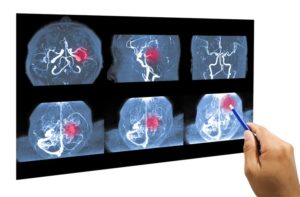
Most people don’t like surprises. Surprise a person with a “surprise” birthday party and someone’s likely to get slugged. Surprises at work — “uh, the boss would like to see you” — are never good. Generally, humans like to know what’s coming up.
That’s why aneurysms are especially sinister. Most brain aneurysms are completely asymptomatic, showing no symptoms. But they’re always there waiting to possibly burst and cause some serious health problems.
We treat brain aneurysms at Texas Neurosurgery. Here’s some more information about these secretive potential killers.
What is an aneurysm?
A brain aneurysm is a bulge or ballooning in a blood vessel in the brain. If you could see it, the aneurysm would usually resemble a berry hanging from a stem. The danger of a brain aneurysm is that it can leak or rupture at any time, causing bleeding into the brain. This is known as a hemorrhagic stroke.
The typical ruptured brain aneurysm occurs in the space between the brain and the thin tissues covering the brain. This type of hemorrhagic stroke is called a subarachnoid hemorrhage.
When a brain aneurysm ruptures, it is a life-threatening episode and needs immediate emergency attention. But most brain aneurysms don’t rupture or create any health issues. They often are found when the patient is having tests done for other conditions.
What are the symptoms of a ruptured aneurysm?
A sudden, severe headache is a key symptom of a ruptured aneurysm. This is an intense headache, probably the worst the person has ever had.
These are common signs of a ruptured aneurysm:
- Sudden, extremely severe headache
- Nausea and vomiting
- Stiff neck
- Blurred or double vision
- Sensitivity to light
- Seizure
- A drooping eyelid
- Loss of consciousness
- Confusion
Treating a ruptured aneurysm
There are two common treatment options for a ruptured brain aneurysm:
- Surgical clipping — A piece of the skull is removed to access the aneurysm and to locate the blood vessel that is feeding it. A tiny metal clip is placed on the neck of the aneurysm to stop blood flow to it.
- Endovascular coiling — This method is far less invasive. A catheter is inserted, usually into the groin artery, and it is threaded through the body up to the aneurysm. A guide wire is used to push a soft platinum wire through the catheter and into the aneurysm. The wire coils up inside the aneurysm, and this disrupts the blood flow and essentially seals off the aneurysm from the artery.
Does someone you know have any of the symptoms of a ruptured aneurysm? Please call the team at Texas Neurosurgery, (214) 823-2052, to schedule an immediate appointment.

